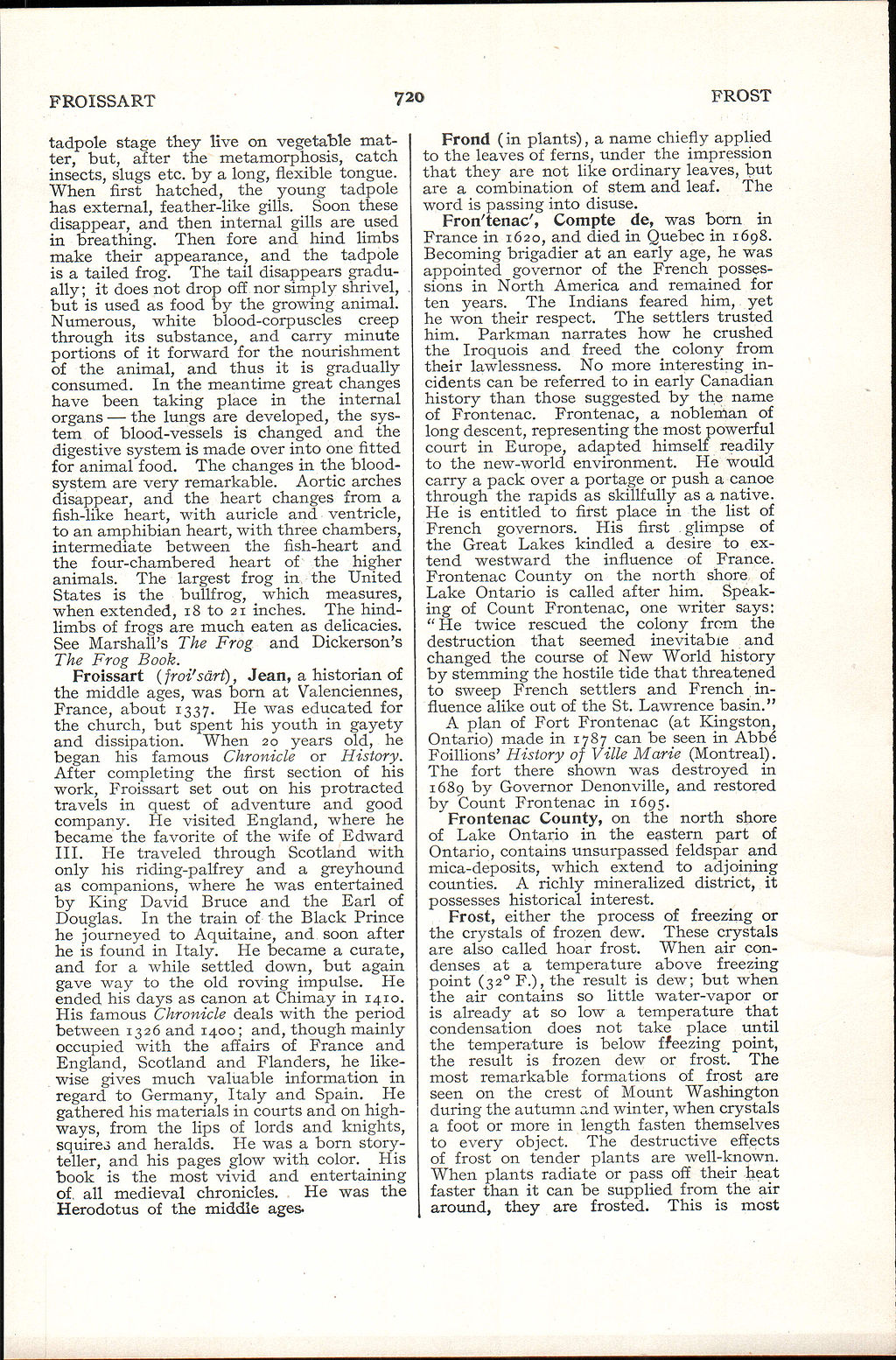PROISSART
720
FROST
tadpole stage they live on vegetable matter, but, after the metamorphosis, catch insects, slugs etc. by a long, flexible tongue. When first hatched, the young tadpole has external, feather-like gills. Soon these disappear, and then internal gills are used in breathing. Then fore and hind limbs make their appearance, and the tadpole is a tailed frog. The tail disappears gradually; it does not drop off nor simply shrivel, but is used as food by the growing animal. Numerous, white blood-corpuscles creep through its substance, and carry minute portions of it forward for the nourishment of the animal, and thus it is gradually consumed. In the meantime great changes have been taking place in the internal organs — the lungs are developed, the system of blood-vessels is changed and the digestive system is made over into one fitted for animal food. The changes in the blood-system are very remarkable. Aortic arches disappear, and the heart changes from a fish-like heart, with auricle and ventricle, to an amphibian heart, with three chambers, intermediate between the fish-heart and the four-chambered heart of the higher animals. The largest frog in the United States is the bullfrog, which measures, when extended, 18 to 21 inches. The hind-limbs of frogs are much eaten as delicacies. See Marshall's The Frog and Dickerson's The Frog Book.
Froissart (froi'sdrt), Jean, a historian of the middle ages, was born at Valenciennes, France, about 1337. He was educated for the church, but spent his youth in gayety and dissipation. When 20 years old, he began his famous Chronicle or History. After completing the first section of his work, Froissart set out on his protracted travels in quest of adventure and good company. He visited England, where he became the favorite of the wife of Edward III. He traveled through Scotland with only his riding-palfrey and a greyhound as companions, where he was entertained by King David Bruce and the Earl of Douglas. In the train of the Black Prince he journeyed to Aquitaine, and soon after he is found in Italy. He became a curate, and for a while settled down, but again gave way to the old roving impulse. He ended his days as canon at Chimay in 1410. His famous Chronicle deals with the period between 1326 and 1400; and, though mainly occupied with the affairs of France and England, Scotland and Flanders, he likewise gives much valuable information in regard to Germany, Italy and Spain. He gathered his materials in courts and on highways, from the lips of lords and knights, squires and heralds. He was a born storyteller, and his pages glow with color. His book is the most vivid and entertaining of. all medieval chronicles. He was the Herodotus of the middle ages-
Frond (in plants), a name chiefly applied to the leaves of ferns, under the impression that they are not like ordinary leaves, but are a combination of stem and leaf. The word is passing into disuse.
Fron'tenac', Compte de, was born in France in 1620, and died in Quebec in 1698. Becoming brigadier at an early age, he was appointed governor of the French possessions in North America and remained for ten years. The Indians feared him, yet he won their respect. The settlers trusted him. Parkman narrates how he crushed the Iroquois and freed the colony from their lawlessness. No more interesting incidents can be referred to in early Canadian history than those suggested by the name of Frontenac. Frontenac, a nobleman of long descent, representing the most powerful court in Europe, adapted himself readily to the new-world environment. He would carry a pack over a portage or push a canoe through the rapids as skillfully as a native. He is entitled to first place in the list of French governors. His first glimpse of the Great Lakes kindled a desire to extend westward the influence of France. Prontenac County on the north shore of Lake Ontario is called after him. Speaking of Count Frontenac, one writer says: "He twice rescued the colony from the destruction that seemed inevitable and changed the course of New World history by stemming the hostile tide that threatened to sweep French settlers and French influence alike out of the St. Lawrence basin."
A plan of Fort Frontenac (at Kingston, Ontario) made in 1787 can be seen in Abb6 Foillioiis' History of Ville Marie (Montreal). The fort there shown was destroyed in 1689 by Governor Denonville, and restored by Count Frontenac in 1695.
Frontenac County, on the north shore of Lake Ontario in the eastern part of Ontario, contains unsurpassed feldspar and mica-deposits, which extend to adjoining counties. A richly mineralized district, it possesses historical interest.
Frost, either the process of freezing or the crystals of frozen dew. These crystals are also called hoar frost. When air condenses at a temperature above freezing point (32° F.), the result is dew; but when the air contains so little water-vapor or is already at so low a temperature that condensation does not take place until the temperature is below ffeezing point, the result is frozen dew or frost. The most remarkable formations of frost are seen on the crest of Mount Washington during the autumn o,nd winter, when crystals a foot or more in length fasten themselves to every object. The destructive effects of frost on tender plants are well-known. When plants radiate or pass off their heat faster than it can be supplied from the air around, they are frosted. This is most
